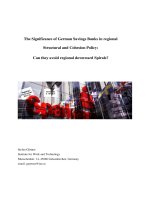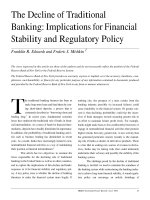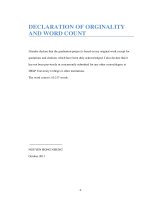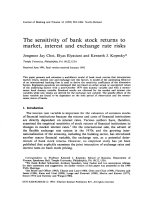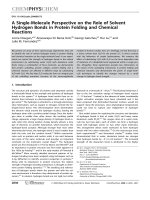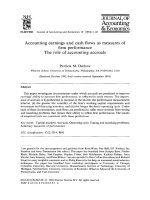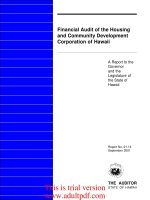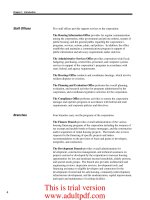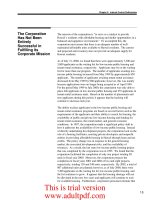Simplifying share based payment accounting: The influence of FASB ASU No.2016-09 on earnings and cash flow volatility
Bạn đang xem bản rút gọn của tài liệu. Xem và tải ngay bản đầy đủ của tài liệu tại đây (379.58 KB, 8 trang )
Accounting and Finance Research
Vol. 8, No. 2; 2019
Simplifying Share-Based Payment Accounting: The Influence of FASB
ASU No.2016-09 on Earnings and Cash Flow Volatility
Stephanie A. Hairston1 & Jaclyn Robelo2
1
Assistant Professor, School of Accountancy, Georgia Southern University, USA
2
Graduate Student, School of Accountancy, Georgia Southern University, USA
Correspondence: Stephanie A. Hairston, Assistant Professor, School of Accountancy, Georgia Southern University,
USA. E-mail:
Received: February 28, 2019
Accepted: March 14, 2019
Online Published: March 15, 2019
doi:10.5430/afr.v8n2p67
URL: />
Abstract
In this study, we examine the influence of the adoption of Accounting Standard Update (ASU) No. 2016-09,
Compensation- Stock Compensation (Topic 718): Improvement to Employee Share-based Payment Accounting, on
earnings and cash flow volatility for firms that issue share-based compensation to employees. Our findings indicate
higher levels of earnings and cash flow volatility after the implementation of ASU 2016-09. We also find that firms
that issue more share-based compensation experience lower levels of earnings and cash flow volatility after the
standard update. This study provides evidence that the simplified accounting treatment of share-based compensation
is associated with significant increases in earnings and cash flow volatility, and that this relationship becomes less
pronounced for firms that issue more share-based compensation. The findings of this study should be useful to policy
makers, regulators, practitioners, and investors evaluating firms that use share-based compensation.
Keywords: share-based compensation, earnings volatility, cash flow volatility
1. Introduction
In this study, we examine the influence of the adoption of Accounting Standard Update (ASU) No. 2016-09,
Compensation- Stock Compensation (Topic 718): Improvement to Employee Share-based Payment Accounting, on
earnings and cash flow volatility for firms that issue share-based compensation to employees. Prior to ASU 2016-09,
excess tax benefits for equity awards were reported as part of additional paid in capital (APIC) on the balance sheet,
and tax deficiencies were offset by APIC with the remaining amount reported as income tax expense (Financial
Accounting Standards Board [FASB], 2016). (Note 1) In addition, excess tax benefits were classified as financing
activities on the statement of cash flows. In an effort to simplify the accounting for employee share-based
compensation, the FASB released ASU No. 2016-09 in the first quarter of 2016. Under ASU No. 2016-09,
companies are required to recognize all excess tax benefits and deficiencies on the income statement regardless of
whether the tax benefits reduce income tax payable in the current period (FASB, 2016). The amendment also
requires that excess tax benefits be reported as a cash flow from operating as opposed to financing activities. As a
result of this change, a tax benefit (deficiency) will decrease (increase) income tax expense and increase (decrease)
net income. (Note 2) Although the amendment does contribute to Financial Accounting Standards Board’s (FASB)
simplification initiative, (Note 3) it may also result in significant earnings and cash flow volatility for firms using
share-based compensation due to the reclassification of excess tax benefits and deficiencies from the balance sheet to
the income statement.
The issue of accounting for employee share-based compensation is economically significant given that many firms
use share-based compensation in their incentive structure for employees. For example, after implementing ASU No.
2016-09 in 2016, Facebook Inc.’s earnings increased to $3.57 billion, up from $1.56 billion a year ago due to the
reduction in their income tax provision related to share-based compensation (Rapport, 2017). In addition, companies
such as Microsoft, Amazon, and Apple that use a great deal of share-based compensation are expected to have
similar benefits from this amendment (Rapport, 2017). This suggests that fluctuations in income and operating cash
flows are likely to be significant due to the change in accounting method for share-based compensation.
We examine the effects ASU 2016-09 on earnings and cash flow volatility using a sample of non-financial firms,
observations from U.S. listed firms for the period 2015-2017. We find that the implementation of ASU 2016-09 does
Published by Sciedu Press
67
ISSN 1927-5986
E-ISSN 1927-5994
Accounting and Finance Research
Vol. 8, No. 2; 2019
create higher levels of earnings and cash flow volatility. We also find that firms that issue more share-based
compensation experience lower levels of earnings and cash flow volatility after the implementation of ASU 2016-09.
The findings of this study should be useful to policy makers and regulators in evaluating the cost and benefits of
simplifying U.S. Generally Accepted Accounting Principles (GAAP), practitioners in determining the influence of
new accounting treatment for share-based compensation on firm performance, and investors evaluating firms that use
share-based compensation.
This study contributes to the existing literature in several ways. First, we provide evidence that the simplified
accounting treatment of share-based compensation is associated with significant increases in earnings and cash flow
volatility. We find a significant positive relationship between earnings volatility and the implementation of ASU
2016-09. Second, we find that the relationship between ASU 2016-09 and earnings and cash flow volatility becomes
less pronounced for firms that issue more share-based compensation. Finally, we show that the FASB’s
simplification of this accounting standard may in fact be beneficial for those firms most affected by the standard.
The remainder of this paper is organized as follows: the second section presents the literature review and hypothesis
development, section three describes the research design, section four presents the empirical results and sensitivity
analysis, and the fifth section concludes.
2. Literature Review and Hypothesis Development
2.1 Accounting for Share-Based Compensation
Share-based compensation refers to the process of granting firm employees ownership in the firm’s equity. The
incentive is regarded as a way to reward their employees, in order to align the interests of firm insiders with
shareholders. The primary advantage of this form of compensation to corporations is that employees can be
compensated without reducing firm profitability.
In the early 1990s, the FASB became concerned with the method of accounting for share-based compensation,
specifically firms were not required to expense stock options on the income statement, which would result in higher
operating expenses. The primary concerns related to this issue were that the value of the issued stock options were
not recognized as compensation expense on the income statement, although the incentives were a form of
compensation. According to prior literature, an accounting standard that does require costs to be recognized results in
unreliable financial statements (Carruth, 2011).
As a result of these concerns, in 1993 FASB issued the exposure draft for “Accounting for Stock-Based
Compensation,” which addressed the recognition of, as compensation expense, and disclosures for stock options in
the financial statements. The accounting standard was established to require companies to expense the fair value of
stock options in their income statements, resulting in lower net income that properly reflects the expense of
share-based compensation. Ultimately, this exposure draft was not approved, which resulted in a 1995 revision of the
same standard. This version gave companies the option to use the alternative intrinsic value method for valuing
share-based compensation, which measured “the compensation cost as the excess of the market price of the stock
over the exercise price of the stock options on the date the options were granted (Carruth 2011, 12).” In addition,
firms are required to disclose in the notes to the financial statements the impact of share-based compensation on net
earnings if the company adopted the fair value method.
However, the valuation of these share-based incentives are drastically influenced by the trading status of the
company, public or private. For a public entity, the fair value of equity, including non-vested shares, is the market
price of their stock on the grant date. Additionally, if shares have a restriction on transferability after vesting, the fair
value needs to reflect a discounted price. On the other hand, if the company is privately held, it is allowed to use its
internal transaction price with a reasonable basis to the grant date fair value (Leahley & Zimmermann, 2007).
Accounting for share-based compensation in this manner, raised concerns related to additional paid in capital (APIC)
pools, liability versus equity classification, minimum tax withholdings for public entities, estimating expected
forfeitures for privately held entities, and measuring share-based payment awards for privately held companies.
Although, ASC 718, Compensation – Stock Compensation, issued in 2014, addressed some of the user concerns by
requiring recognition of compensation cost for share-based payments in net income (Nichols, Betancourt, & Scott,
2017), there were still lingering concerns about accounting for share-based compensation. As a result, ASU 2016-09
was implemented to simplify the accounting for share-based compensation in specific areas causing the cost and
complexity of reporting to decrease without affecting the usefulness of the information provided by the financial
statements (Nichols et al., 2017).
Published by Sciedu Press
68
ISSN 1927-5986
E-ISSN 1927-5994
Accounting and Finance Research
Vol. 8, No. 2; 2019
ASU 2016-09 will impact many different aspects of the tax reporting in the financial statements. First, it will affect
the income tax provision, share-based compensation will be accounted for by recognizing all the tax benefits
(deficiencies) as income tax expense in the reporting period in which the compensation occurred. In addition, all
excess tax benefits need to be recognized regardless of whether it reduces taxes payable. On the statement of cash
flows, the excess tax benefits from the share-based compensation will be reported along with all other income tax
cash flows as an operating activity. Similarly, the cash paid by the employer related to tax withholding for
share-based compensation will also be classified as a cash flow in the financing activity section of the statement of
cash flows.
In order to estimate the amount of tax related to share-based compensation, the company must either estimate the
number of awards that are expected to vest or account for the forfeitures when they occur. However, accounting for
privately held corporations will be significantly less cumbersome. Nonpublic entities will make an election to
estimate the expected time period for all awards with performance or service to meet certain conditions, or they can
elect to switch from fair value accounting for all liability classified awards to intrinsic value.
2.2 Share-Based Compensation and Cash Flow Volatility
Under the previous guidance, excess tax benefits were viewed as a financing transaction, and were therefore
presented in financing activities on the statement of cash flows. However, this transaction does not involve any cash
transfer, it is caused by a reduction in income taxes payable. This reduction is the result of firms deferring income
taxes during the vesting period for share-based compensation, which results in the creation of deferred tax assets. In
order to properly reflect this non-cash transaction on the statement of cash flows, firms were required to show an
inflow in the financing section and an outflow in the operating section related to the income taxes payable (Kim,
Morris, & Franco, 2018). The issue with this non-cash transaction is that the difference between the income tax
payable and income tax expense needs to be recognized as APIC which can later be transferred into the deferred tax
asset account. However, this issue has been resolved under ASU 2016-09. The new standard provides guidance
that allows firms to classify the excess tax benefits directly with all the cash flows related to income taxes in the
operating activities section of the statement of cash flows.
Previously, the cash inflow and outflow related to share-based compensation was based on hypothetical projections
of share-based compensation that was to be granted to employees during a specified time period. This suggests that
firms may have been able to artificially reduce cash flow volatility by adjusting their projections. The changes
involved with ASU 2016-09 will create a more credible statement of cash flows where the tax benefits (deficits) will
be based on the actual share-based compensation issued, which minimizes the opportunity for firms to minimize
volatility. Following this line of reasoning, we state our first hypothesis as follows:
H1: The implementation of ASU 2016-09 will significantly increase cash flow volatility.
2.3 Share-Based Compensation and Earnings Volatility
Under previous accounting guidance, excess tax benefits were recognized in APIC and tax deficiencies were
recognized as an offset to APIC or as part of earnings (Rashty, 2018). ASU 2016-09 eliminates APIC and all the
excess tax deficiencies (benefits) are reflected in current period earnings. As a result, the volatility of earnings is
likely to increase due to the elimination of the APIC pool as well as the excess tax benefits and deficiencies. In
addition, under the previous accounting guidance for share-based compensation, the excess tax benefits were realized
through a reduction to current income taxes payable (Rashty, 2018). This reduction delayed the recognition of any
excess tax benefits. Under the new accounting standard, the excess tax benefits (deficiencies) are recognized in
earnings which impacts both net income and earnings per share.
Accounting for share-based compensation under ASU 2016-09 is likely to create more earnings volatility given its
impact on the company’s income statement, through income tax expense, effective tax rate, and earnings per share
(Spinelli, 2016). As a result, we expect that this new standard will significantly increase earnings volatility after
implementation, and we state our second hypothesis as follows:
H2: The implementation of ASU 2016-09 will significantly increase earnings volatility.
3. Methodology
3.1 Cash Flow and Earnings Volatility Models
Following Edmonds, Edmonds, Leece, & Vermeer (2015), a linear regression model is used to predict the effects of
ASU 2016-09 on earnings and cash flow volatility. The following linear regression models are used to measure the
relation between the implementation of ASU 2016-09 and cash flow and earnings volatility in testing H1 and H2:
Published by Sciedu Press
69
ISSN 1927-5986
E-ISSN 1927-5994
Accounting and Finance Research
Vol. 8, No. 2; 2019
VOL𝒊,𝒕 = β0 + β1 ASU𝒊,𝒕 + β2 OPTIONS𝒊,𝒕 + β3 ASU𝒊,𝒕 ∗ OPTIONS𝒊,𝒕 +γ1 LEVERAGE𝒊,𝒕 + γ2 MTB𝒊,𝒕 + γ3 SIZE𝒊,𝒕 +
γ4 ACCRUALS𝒊,𝒕 + γ5 EARNTOPRICE𝒊,𝒕 + 𝜺𝒊,𝒕
(1)
The dependent variable VOL𝒊,𝒕 is one of two volatility measures, earnings volatility (EARN_VOL𝑖,𝑡 ) or cash flow
volatility (CASH_VOL𝑖,𝑡 ). EARN_VOL𝑖,𝑡 , is measured as the average of the standard deviation of quarterly income
before taxes and loan loss provisions (EBITDA) scaled by total assets. CASH_VOL𝑖,𝑡 , is measured as the standard
deviation of quarterly operating cash flows scaled by total assets. The remaining variables included in the regression
model are measured as follow:
ASU𝑖,𝑡 = an indicator variable equal to one if ASU 2016-09 is effective, and zero otherwise;
OPTIONS𝑖,𝑡 = an indicator variable equal to one if the number of options awarded is above the sample median, and
zero otherwise.
LEVERAGE𝑖,𝑡 = the natural log of total liabilities;
MTB𝑖,𝑡 = the ratio of the market value of equity to the book value of equity;
SIZE𝑖,𝑡 = the natural log of firm i’s total assets;
ACCRUALS𝑖,𝑡 = the absolute value of the difference between income before extraordinary items and net operating
cash flows;
EARNTOPRICE𝑖,𝑡 = the ratio of net income to stock price ratio.
PPE𝑖,𝑡 = total property, plant and equipment scaled by total assets.
ROA𝑖,𝑡 = net income scaled by average total assets.
3.2 Sample Selection
Financial information necessary to estimate the regression models was obtained from COMPUSTAT. Observations
were required to have sixteen consecutive quarters of earnings data in addition to financial data, which resulted in a
final sample of 12,511 firm quarter observations.
4. Results
4.1 Descriptive Statistics and Correlations
Table 1 reports descriptive statistics for the full sample over the sample period from 2015 to 2017. The average
market-to-book ratio (MTB) and return on assets (ROA) of firms included in the sample are 3.105 and 0.008. In
addition, on average property, plant, and equipment (PPE) represents 56.8 percent of total assets in sample firms.
The mean cash flow and earnings volatility of firms included in sample are 0.045 and 0.021. We also note that the
standard deviation of the cash flow and earnings volatility variables are 0.035 and 0.051, which suggests that there is
significant variation in volatility for firms included in the sample.
Table 1. Descriptive Statistics
Variable
Mean
Std. Dev.
Q1
Median
Q3
CASH_VOL
0.045
0.035
0.027
0.038
0.053
EARN_VOL
0.021
0.051
0.005
0.009
0.020
ASU
0.071
0.257
0.000
0.000
0.000
OPTIONS
0.450
0.498
0.000
0.000
1.000
LEVERAGE
0.613
0.279
0.447
0.605
0.738
MTB
3.105
10.651
1.481
2.404
4.071
SIZE
8.146
1.661
6.954
8.048
9.220
ACCRUALS
−0.045
0.082
−0.068
−0.035
−0.009
EARNTOPRICE
−0.016
0.155
0.002
0.010
0.016
PPE
0.568
0.481
0.201
0.433
0.853
ROA
0.008
0.040
0.001
0.011
0.022
This table reports the descriptive statistics for variables used in the regression analysis.
Published by Sciedu Press
70
ISSN 1927-5986
E-ISSN 1927-5994
Accounting and Finance Research
Vol. 8, No. 2; 2019
Table 2 presents the Pearson and Spearman correlations for the variables used in the cash flow and earnings volatility
models. We find that the implementation of ASU 2016-09 is negatively and significantly associated with cash flow
and earnings volatility, which is counter to our expectations. However, this correlation may be the result of a lack of
controls. We also note that the correlation coefficient for OPTIONS is significant and positively associated with cash
flow volatility, but negatively and significantly associated with earnings volatility.
Table 2. Correlation Matrix
(1)
(2)
(3)
(4)
(5)
(6)
(7)
(8)
(9)
(10)
(11)
0.406
−0.008
0.024
−0.256
0.250
−0.366
−0.143
0.007
0.080
0.317
−0.021
−0.031
−0.099
−0.096
−0.368
−0.201
−0.252
0.128
−0.146
0.067
0.035
0.047
0.056
0.156
0.035
0.001
0.046
0.012
0.122
0.094
0.038
−0.003
−0.023
0.083
0.020
0.433
0.027
0.013
0.081
−0.185
0.052
0.057
0.078
−0.161
0.422
0.114
0.141
0.014
−0.035
0.321
−0.286
0.261
−0.115
0.742
1
CASH_VOL
2
EARN_VOL
0.344
3
ASU
−0.026
−0.039
4
OPTIONS
0.016
−0.021
0.067
5
LEVERAGE
−0.010
0.058
0.036
0.024
6
MTB
0.043
−0.037
0.026
0.011
−0.061
7
SIZE
−0.340
−0.322
0.056
0.083
0.291
0.027
8
ACCRUALS
−0.062
−0.218
0.110
0.046
−0.068
0.020
0.106
9
EARNTOPRICE
0.016
−0.271
0.039
0.047
−0.178
0.032
0.072
0.472
10
PPE
0.012
0.138
−0.011
−0.045
0.148
−0.059
0.014
−0.377
−0.266
11
ROA
0.156
−0.270
0.044
0.053
−0.140
0.045
0.057
0.533
0.630
−0.141
−0.245
Table 3 presents the Pearson and Spearman correlations of all variables used in the regression model. Pearson correlations appear
below the diagonal, and Spearman correlations appear above the diagonal. Correlations coefficients significant at least at the 0.05
level appear in bold.
4.2 Cash Flow Volatility Results
Table 3 presents the results of the cash flow volatility regression. Model (1) presents the results of the regression
model estimating cash flow volatility over eight quarters, model (2) presents the results estimating cash flow
volatility over 12 quarters, and model (3) presents the results estimating cash flow volatility over five years (20
quarters). We find that ASU is positively and significantly related to cash flow volatility in each of the models;
however, we do not find a significant relationship between executive stock options (OPTIONS) and cash flow
volatility. Additionally, we find that the cash flow volatility of firms that issue more options are not adversely
affected by the issuance of ASU 2016-09; specifically, we find that the interaction term between the implementation
of ASU 2016-09 and firms issuing options (ASU*OPTIONS) is negative and significant. The findings suggest that
overall ASU 2016-09 is associated with higher levels of cash flow volatility, which is consistent with H1; however,
the standard results in a reduction of cash flow volatility for firms that issue more stock options.
Published by Sciedu Press
71
ISSN 1927-5986
E-ISSN 1927-5994
Accounting and Finance Research
Vol. 8, No. 2; 2019
Table 3. Effect of ASU 2016-09 on Cash Flow Volatility
CASH_VOL
(1)
ASU
OPTIONS
ASU*OPTIONS
LEVERAGE
MTB
SIZE
ACCRUALS
EARNTOPRICE
0.008
(2)
***
Observations
***
(7.855)
0.002
0.002
0.002
(1.471)
(1.264)
(1.384)
−0.004
−0.005
(−1.557)
(−1.723)
0.019
***
0.023
*
−0.007
***
0.023
***
(3.483)
(3.686)
0.000
0.000
0.000
(1.174)
(1.271)
(1.105)
−0.006
***
−0.007
***
−0.008
(−8.175)
(−7.886)
(−8.607)
−0.021
−0.015
0.012
(−0.756)
(−0.597)
(0.576)
−0.007
−0.013
(−0.877)
(−1.578)
−0.011
*
0.011
***
0.013
***
(4.650)
0.128
***
0.098
**
0.066
0.014
***
***
(5.778)
***
(4.970)
0.065
**
(−2.562)
(3.722)
(7.501)
CONSTANT
0.012
(6.042)
(3.487)
ROA
***
(6.000)
(−1.783)
PPE
0.010
(3)
0.065
**
(2.151)
***
0.071
***
(2.045)
(3.790)
(6.424)
12,511
12,511
12,511
Adj. R-squared
0.257
0.260
0.277
Year Fixed Effects
Yes
Yes
Yes
Industry Fixed Effects
Yes
Yes
Yes
*, **, *** Denote statistical significance at the 10 percent, 5 percent, and 1 percent levels, respectively.
This table presents the results of regressing cash flow volatility on the implementation of ASU 2016-09 (ASU) and
options awarded (OPTIONS). Model (1) presents the results of the regression model estimating cash flow volatility
over eight quarters, model (2) presents the results estimating cash flow volatility over 12 quarters, and model (3)
presents the results estimating cash flow volatility over five years (20 quarters). All test statistics and significant levels
are estimated based on the standard errors adjusted by a two-dimensional cluster at the firm and year/quarter level.
Fixed effects are included for year and industry.
4.3 Earnings Volatility Results
We presents the results of the tests of H2 on the effect of the implementation of ASU 2016-09 and executive stock
options on earnings volatility in Table 4. Model (1) presents the results of the regression model estimating earnings
volatility over eight quarters, model (2) presents the results estimating earnings volatility over 12 quarters, and model
(3) presents the results estimating earnings volatility over five years (20 quarters). We find that ASU is positively
and significantly related to earnings volatility in each of the models; however, we do not find a significant
relationship between executive stock options and earnings volatility. Additionally, we find that the earnings volatility
Published by Sciedu Press
72
ISSN 1927-5986
E-ISSN 1927-5994
Accounting and Finance Research
Vol. 8, No. 2; 2019
of firms that issue more options are not adversely affected by the issuance of ASU 2016-09; specifically, we find that
the interaction term between the implementation of ASU 2016-09 and firms issuing options (ASU*OPTIONS) is
negative and significant. The findings suggest that overall ASU 2016-09 is associated with higher levels of earnings
volatility, which is consistent with H2; however, the standard results in a reduction of earnings volatility for firms
that issue more stock options.
Table 4. Effect of ASU 2016-09 on Earnings Volatility
EARN_VOL
(1)
ASU
OPTIONS
ASU*OPTIONS
LEVERAGE
MTB
SIZE
ACCRUALS
EARNTOPRICE
PPE
ROA
(2)
0.016
***
Observations
***
0.013
***
(3.554)
(3.930)
(4.293)
0.001
0.001
0.000
(0.452)
(0.496)
(0.086)
−0.004
−0.005
(−1.542)
(−1.969)
0.028
***
0.028
**
−0.004
*
(−1.840)
***
0.033
***
(2.849)
(3.427)
(4.304)
0.000
0.000
0.000
(1.450)
(1.515)
(0.463)
−0.007
***
−0.007
***
−0.009
***
(−3.886)
(−4.369)
(−5.727)
0.095
0.077
0.075
(1.632)
(1.610)
(1.665)
−0.043
***
−0.034
***
*
−0.027
***
(−3.716)
(−3.721)
(−2.812)
0.004
0.003
0.004
(0.718)
(0.695)
(0.885)
−0.272
***
(−37.740)
CONSTANT
0.015
(3)
−0.235
***
(−8.941)
0.047
***
0.048
−0.223
***
(−3.460)
***
0.061
***
(3.749)
(4.010)
(5.586)
12,511
12,511
12,511
Adj. R-squared
0.195
0.212
0.215
Year Fixed Effects
Yes
Yes
Yes
Industry Fixed Effects
Yes
Yes
Yes
*, **, *** Denote statistical significance at the 10 percent, 5 percent, and 1 percent levels, respectively.
This table presents the results of regressing earnings volatility on the implementation of ASU 2016-09 (ASU) and
options awarded (OPTIONS). Model (1) presents the results of the regression model estimating earnings volatility over
eight quarters, model (2) presents the results estimating earnings volatility over 12 quarters, and model (3) presents the
results estimating earnings volatility over five years (20 quarters). All test statistics and significant levels are estimated
based on the standard errors adjusted by a two-dimensional cluster at the firm and year/quarter level. Fixed effects are
included for year and industry.
Published by Sciedu Press
73
ISSN 1927-5986
E-ISSN 1927-5994
Accounting and Finance Research
Vol. 8, No. 2; 2019
5. Conclusion
Through the FASB’s simplification initiative, the amendment ASU 2016-09 was released in order to simplify the
recording of share-based compensation in companies’ financial statements. Since 2016, companies such as Facebook,
Microsoft, and Amazon have achieved substantial gains by implementing the standard, which may be indicative of
potential earnings and cash flow volatility related to the standard. As such, in this study, we examine the impact of
the implementation of ASU 2016-09 on cash flow and earnings volatility. The results indicate that ASU 2016-09
results in more cash flow and earnings volatility; however, the relationship is mitigated for firms that issue more
stock options.
To the best of our knowledge, this study is one of the first to empirically examine the relationship between the
implementation of ASU 2016-09 and volatility in financial statements. However, we also note that no study is
without limitations, we note that our study is primarily a practical study and as such may lack some theoretical
framework in the development of our argument. Future research should attempt to bridge the gap between theory and
practice in examining this area. Our findings contribute to the academic literature involving this amendment and how
it affects the earnings and cash flow volatility of companies, as well as the presentation and credibility of the
financial statements.
References
Carruth, P.J. (2012). Accounting for Stock Options: A Historical Perspective. Journal of Business & Economics
Research, 1(5), 9-14.
Financial Accounting Standards Board. (2016). Improvements to Employee Share-Based Payment Accounting.
Retrieved
from:
/>Edmonds, C.T., Edmonds, J.E., Leece, R.D., & Vermeer, T.E. (2015). Do risk management activities impact
earnings
volatility?
Research
in
Accounting
Regulation,
27(2015),
66-72.
/>Kim, S., Morris, R., & Franco, J. (2018). FASB simplifies the accounting for share-based payments. Heads Up,
Deloitte, 25(6), 1-13.
Leahey, A.L., & Zimmermann, R.A. (2007). A road map for share-based compensation. Journal of Accountancy,
123(4), 50-54.
Nichols, N., Betancourt, L., & Scott, I. (2017). The FASB simplifies the accounting for share-based payments.
Journal of Corporate Accounting & Finance, 28(4), p.8-19. />Rapoport, M. (2017). Facebook earnings enjoy a nearly $1 billion tax windfall from accounting change. The Wall
Street Journal. Dow Jones & Company, Inc., Web. 2 Apr. 2017. Retrieved from:
/>44709.
Rashty, J. (2018). Changes to accounting for employee share-based payment. The CPA Journal, 88(3), 56-59.
Spinelli, C. (2016). Share-based payment accounting simplifications. BKD CPAs & Advisors, Web. 30 Apr. 2018.
Retrieved from: />Notes
Note 1. Excess tax benefits (deficiencies) for equity awards occur when compensation costs from non-qualified
share-based compensation recognized on the entity's tax return exceeds (is less than) compensation cost from
equity-based compensation recognized in financial statements.
Note 2. Prior to ASU 2016-09, tax deficiencies increased income tax expense unless there was a tax benefit
previously reported in additional paid in capital to offset the tax deficiency.
Note 3. The FASB states that their simplification initiative is designed to “identify, evaluate, and improve areas of
generally accepted accounting principles (GAAP) for which cost and complexity can be reduced while maintaining
or improving the usefulness of the information provided to users of financial statements (FASB, 2016).”
Published by Sciedu Press
74
ISSN 1927-5986
E-ISSN 1927-5994
